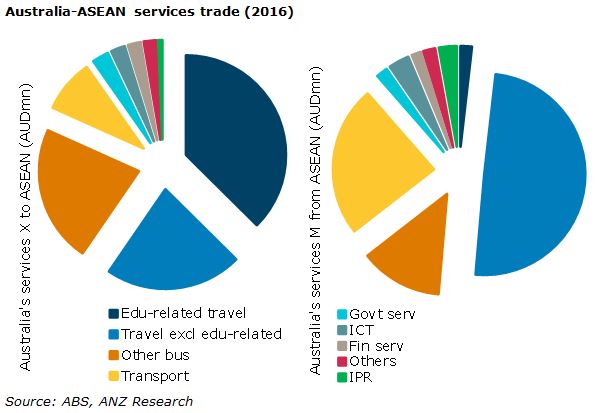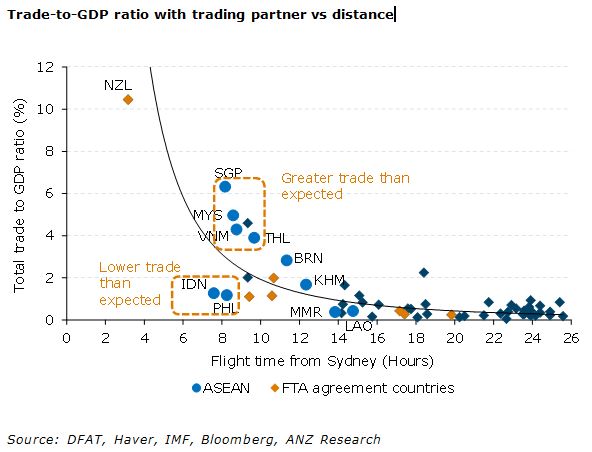-
The ASEAN (The Association of Southeast Asian Nations) bloc is Australia’s third-largest trading partner after China and Europe. It’s a region rich in opportunity yet its share of trade has remained stagnant in recent years.
In the year to September ASEAN accounted for 13.7 per cent of Australia’s total two-way goods and services trade, more than A$100 billion. Of that, merchandise trade was roughly $A72 billion with services accounting for $A28 billion.
“There is an absence of diversification in terms of country and sectors, particularly in services.”
The stagnation comes as Australia’s trade with China expands rapidly. But when we look at ASEAN flows, there is an absence of diversification in terms of country and sectors, particularly in services.
ASEAN’s strong growth, rising urban population, favourable demographics, growing middle class and geographical proximity to Australia mean there is tremendous scope for increased trade and investment flows.
But this opportunity will not be maximised if the current strong country and sector concentration remains.
No surprise
Singapore, Thailand, Malaysia, and Indonesia account for over 80 per cent of the total trade between Australia and ASEAN.
By category, ASEAN’s biggest goods exports to Australia are machinery and transport equipment and specific manufactured goods like big vehicles, which has seen little diversification over the years.
At the other end, soft commodities form the bulk of Australia’s major exports to ASEAN, although they are not primary exports to the world.
ASEAN’s largest services export earner for Australia is from international students and tourism with spending by Australian tourists account for almost half of the total services imports from ASEAN.
A large proportion of two-way services trade, especially outside of tourism and education, is heavily concentrated with Singapore.
{CF_IMAGE}
{CF_IMAGE}
The stock of two-way investments between Australia and ASEAN stands at only 4.2 per cent of the total despite total trade with ASEAN accounting for 13.7 per cent.
Singapore accounts for a large part of the stock of investment with Australia in both directions. Malaysia comes a distant second.
Given Singapore’s status as a financial centre and a high income economy, alongside the close ties with Australia through the Comprehensive Strategic Partnership, it is no surprise there are stronger investment linkages between the two countries.
{CF_IMAGE}
While Singapore has the highest per capita GDP amongst ASEAN, it has the second smallest population size and economic growth rates which will lag behind the other countries given the stage of its development.
There is a limit to how much more trade and investment can grow between Australia and Singapore. Therefore, the bigger opportunities lie in diversifying and expanding into the other ASEAN economies, especially those in the middle income group with rising levels of urbanisation.
Where Australia can get the bigger lift from trade with ASEAN
The extent of bilateral trade between two countries is determined by many things but it is generally proportional to size as measured by GDP and inversely proportional to distance.
The openness of each economy and existence of common language and historical links are also important. But size and distance are generally seen as the two key variables in what is known as the gravity equation in international trade.
The chart below shows this relationship across Australia’s top 60 trading partners which account for 95 per cent of Australia’s total goods and services trade.
We plot the total trade-to-GDP ratio against distance, measured as the flight time from Sydney to the major commercial centre of that trading partner, factoring in stopovers and transit times.
Not surprisingly, New Zealand stands out in terms of the trade-to-GDP ratio given its close proximity to Australia. The trade-to-GDP ratio tends to decline the further the distance.
{CF_IMAGE}
The existence of trade agreements which lower trade barriers and include more products under their scope generally facilitate trade.
We have highlighted the 10 ASEAN economies, as well as those countries that have FTAs with Australia.
What we see is Australia’s trade with FTA countries do not appear to see a higher trade-to-GDP ratio than implied by distance. But for some ASEAN countries, there is a noticeable outperformance in terms of their trade linkages.
Singapore, Malaysia, Vietnam, and Thailand’s overall trading relationship with Australia is greater than what would be expected based on distance.
Surface
On the surface, this would suggest the ASEAN-Australia-New Zealand Free Trade Agreement (AANZFTA), which came into existence in 2010, may have been behind the trade outperformance.
However, it was found companies still depended heavily on bilateral FTAs to conduct trade rather than to rely on the AANZFTA.
This means Australia’s better trade ties with Singapore, Malaysia, and Thailand can be attributed more to the bilateral FTAs with those countries than the AANZFTA.
This could also explain why the trade relationship with Indonesia and the Philippines are not as strong as they should be based on distance.
In fact, if the trade-to-GDP ratio for Indonesia and the Philippines is increased to two, which is half of Thailand’s ratio, it would result in an additional $US10 billion worth of two-way trade. This would be a 13 per cent increase in the current trade relationship between Australia and the whole of ASEAN.
With Indonesia being ASEAN’s largest economy and most populous member, and the Philippines one of the strongest growing economies in the region, there is a lot more scope for much stronger trade ties.
The Indonesia-Australia Comprehensive Economic Partnership is currently under negotiations. A successful conclusion could help lift Indonesia’s trade to GDP ratio closer to other ASEAN countries with existing bilateral FTAs.
To read more insights into the ASEAN Special Summit click here.
Khoon Goh is Head of Asia Research at ANZ
The views and opinions expressed in this communication are those of the author and may not necessarily state or reflect those of ANZ.
-
-
-
-
anzcomau:Bluenotes/asia-pacific-region,anzcomau:Bluenotes/global-economy
ASEAN: the case for diversification
2018-03-13
/content/dam/anzcomau/bluenotes/images/articles/2018/March/KhoonASEAN_banner.jpg
EDITOR'S PICKS
-
The ASEAN opportunity provides learnings from the China experience for Australian businesses.
9 March 2018 -
NZ trade with ASEAN is growing but there are several potential areas it can be enhanced.
13 October 2017




